Are you stuck trying to decide between a Fender 2 vs 6 point tremolo bridge? Although each type has its pros and cons, there is no one best choice. It depends on many factors, but most importantly, it comes down to which tremolo bridge works best for you.
Keep reading to learn more about comparing Strat bridge tremolo types and get my tremolo evaluation checklist.
You can use the table of contents below to take you to the area that interests you. Click on the little box to open it and then click on the section of the article you want to read, or you can read from start to finish if you want the full tremolo bridge experience!
The Short Answer
Fender Two and six-point tremolo bridges each have pros and cons in terms of setup, ease of adjustment, tuning stability, resonance and sustain, spring configuration, functionality, and appearance. One tremolo bridge type is not better than the other. You should play a variety of guitars and get the tremolo that works and sounds best to you. There are many guitar models that offer both tremolo types.
Keep On Reading (Below) To Learn More
2 Vs. 6-Point, What’s The Difference?
In this article, I am essentially comparing the two types of Fender Stratocaster bridges, although there is a section that briefly talks about Floyd Rose bridges.
So, what are the fundamental differences between the Fender 2 vs. 6-point tremolo bridge?
In The Beginning, The 6-Point Tremolo Bridge
Fender released the Stratocaster in 1954. It was their first solid-body guitar to feature a tremolo bridge. The bridge was screwed onto the guitar’s body at six points, which allowed it to pivot up and down to create the tremolo (actually vibrato) effect.
Look at the image below, and you’ll see the six screw holes marked by arrows.
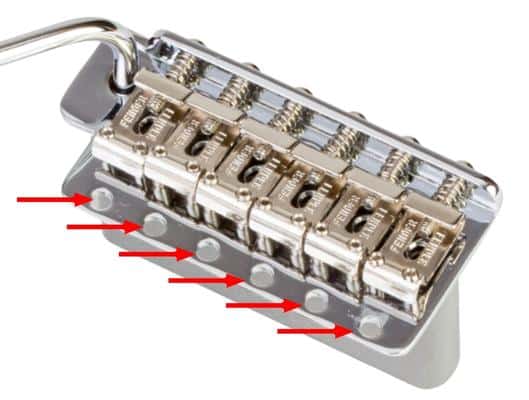
Enter The 2-Point Fulcrum Tremolo Bridge
Fender released its version of the 2-point tremolo bridge in 1986, ten years after the appearance of the Floyd Rose double-locking bridge in 1976. The Floyd Rose system was different because it “locked” the strings at the bridge and nut for better tuning stability during aggressive whammy bar use.
The new Fender bridge was meant to give it more freedom of movement with less friction. It pivoted on two “knife edges (see arrows below) against mounting studs that were screwed into the guitar’s body.
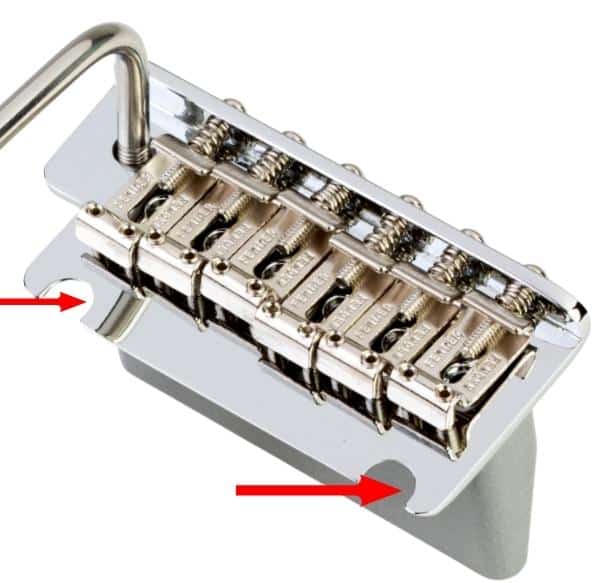
Tremolo Bridge Comparison: 2 Vs 6 Point
Here is a table that compares the 2-point bridge to the original 6-point design. The information is somewhat based on my opinion but is generally considered to be true by most players.
| Comparison | 2-Point Tremolo Bridge | 6-Point Tremolo Bridge |
|---|---|---|
| Set Up | Can be floating or decked | Can be floating or decked |
| Ease Of Adjustment | Easier | Harder |
| Tuning Stability | Better | Worse |
| Resonance And Sustain | Less | More |
| Spring Configuration | Up to five springs | Up to five springs |
| Functionality | More responsive | Less Responsive |
| Appearance | Modern | Vintage |
These days, multiple guitar models are available with the 2-point and 6-point tremolo bridges, so the choice is up to you.
Keep On Reading (Below) To Learn More About Each Topic
Tremolo Evaluation Checklist

Here is a simple checklist you can use when trying out a guitar. It can help you decide if a particular tremolo bridge works with your playing technique.
Remember that the string gauge may need to be changed, and/or the bridge may need to be adjusted to get it to work best.
- Does the whammy bar move up and down comfortably?
- Does the guitar stay in tune as you play?
- Are you able to make subtle pitch changes accurately?
- Do the notes sustain properly when you move the bar up and down?
- Does the tremolo bridge type complement the look of the guitar?
If you purchase the guitar, negotiate a free setup into the deal.
Set Up
Both types of tremolo bridges can be set up to float or be decked. What’s the difference? Let’s have a quick look.
Floating Tremolo
A floating tremolo is set up so that the whammy bar can be pushed down to loosen the strings or pulled up to tighten them. This type of setup has become increasingly popular, especially since the early 1980s when whammy bar “tricks” became more prevalent in Rock and Metal.
The downside of a floating tremolo bridge is that it’s easier to put the guitar out of tune. Additionally, if you break a string while paying, the other five strings will all be sharp! Professional players have at least one backup guitar to deal with just such an occurrence.
I have the tremolo bridges on all my Strats and Super Strats set up to float, but it’s your choice. There’s no right or wrong way to do it.
Decked Tremolo
A decked tremolo is set up so the tremolo bridge plate sits flush against the guitar’s body. The whammy bar can be pressed down to loosen the strings but not pulled up to tighten them.
This is how Fender Stratocasters were typically set up at the factory until the early 1980s when floating tremolos became more popular.
If you don’t use your whammy bar, you should deck your tremolo bridge for maximal tuning stability.
What About Decked Vs. “Blocked”?
Most players that never use the whammy bar have it decked, but some players put a piece of wood between the tremolo block and the back of the tremolo cavity. You can block a 2-point and a 6-point tremolo bridge.
Eric Clapton prefers the tremolo bridges on his guitars blocked, and his Signature Strats all come with a factory-installed wooden block, as seen below (you can see the 9-volt battery for the onboard mid-range booster).

With “Blocked” Tremolo
So, what’s the difference between a Strat with a blocked tremolo bridge and a Strat with a hardtail (non-tremolo) bridge? It’s the springs that give a Strat a certain “dimensional shimmer” to its sound. You can hear it, even with the guitar unplugged. A hardtail bridge has no springs because it doesn’t move.
I have an Eric Clapton Signature Strat and a hardtail Strat that I built. I can assure you that the sound between these two types of guitars is very noticeable!
See Floating Vs Decked Vs Blocked Tremolo Bridge – 3 Great Setups! for more info.
Ease Of Adjustment
For a floating setup (see above), I find that 2-point tremolo bridges are typically easier to adjust than 6-point bridges. This is especially true if you want the bridge to float enough to pull a note up more than one whole-tone.
A 6-point tremolo bridge moves on a beveled edge, while a 2-point bridge moves on a “knife edge,” which gives it more freedom of mobility.
Tuning Stability
I find that the 2-point tremolo bridges have better tuning stability than the 6-point bridges for many of the same reasons that make them easier to adjust.
For 6-point tremolos, I have the best luck setting up Paul Reed Smith guitars. They really maintain their tuning stability.
Self-lubricating nuts, roller nuts, and locking tuners can improve the tuning stability of both bridge types.
Resonance And Sustain
In the resonance and sustain department, I usually find the 6-point tremolo bridges to be the clear winner. The more the body and neck of a guitar resonate, the better it usually sustains notes.
Although the 2-point tremolo bridges have two large studs embedded into the body of the guitar, the screw arrangement of the 6-point bridge usually conducts sound better into the guitar’s body, making it resonate more.
Additionally, the tremolo blocks on the older 6-point bridge guitars seem to give the instruments more sustain. Of course, you can always upgrade the tremolo block on your two or six-point bridge for better results.
Spring Configuration
Both the 2-point and 6-point tremolos can take up to five springs. In the old days, Fender shipped all its Strats loaded with five springs and a decked bridge setup.
When floating bridges became popular, Fender began shipping them set up with three springs to make the whammy bar function smoother.
There is quite a bit of “mystique” centered around how to attach the springs in the tremolo cavity between the tremolo block and spring mounting claw.
Some players prefer using three springs that line up parallel to each other.
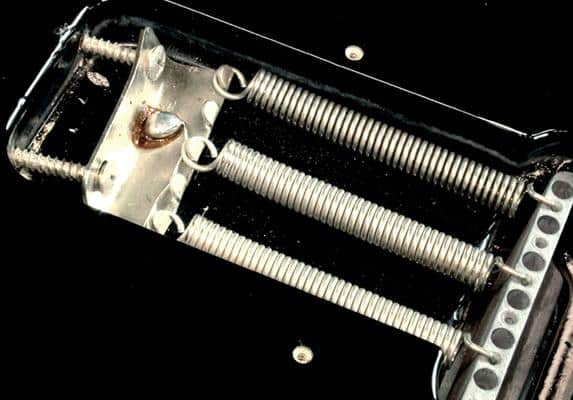
Other players arrange the three springs in an angled configuration.
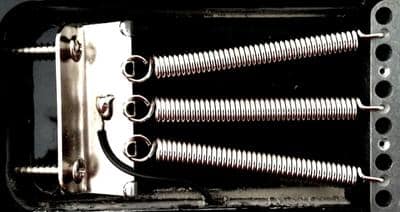
I find that each of these spring configurations can make a difference in the tremolo function and the guitar’s overall sound, but it can vary from one instrument to another. The best approach is to try both spring setups and select the one you like best.
Does Spring Material Matter?
The spring material can make a difference in playability and sound. Fender has used two types of springs over the years.
The Strats with the 6-point tremolos typically have the original metal (silver) springs.
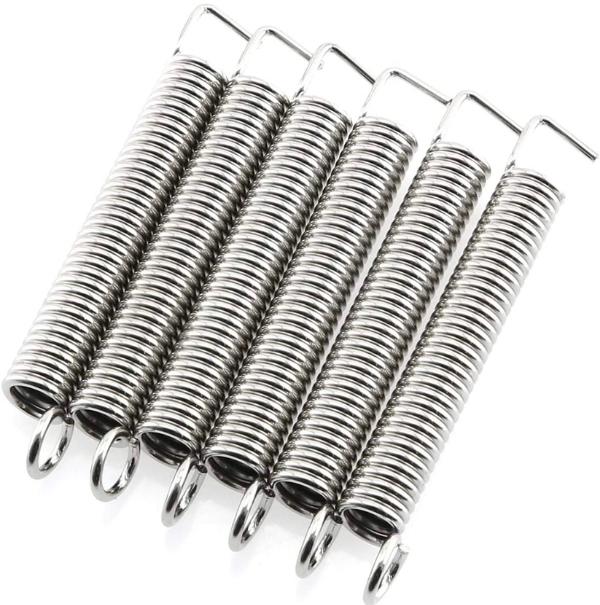
Strats with a 2-point tremolo typically have metal springs with a black oxide finish, which is supposed to eliminate “spring squeak” for a quieter performance.
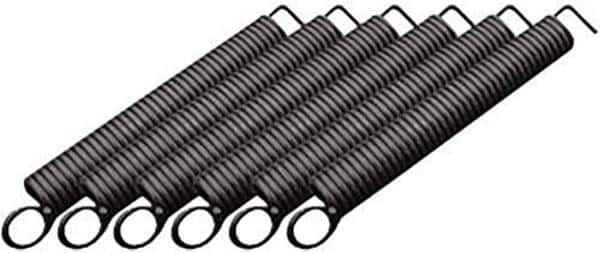
Both types of springs can be used interchangeably on the two and six-point tremolo bridges. Some players also substitute the springs with those from other manufacturers, like Floyd Rose or Wilkinson.
You can try both spring types and use the ones that work and sound best.
Functionality
Ask different players about the functionality of two versus six-point tremolo bridges, and you’re likely to get various opinions.
I find the 2-point tremolo bridges easier to use for very subtle sting vibrato sounds, while the 6-point bridges are not as smooth but keep a more constant string tone, especially when lowering a note down more than one whole-tone.
The real key to using both vibrato bridges expressively is to keep the whammy bar from shimmying where it is screwed into the bridge. Many players don’t know that there is supposed to be a tremolo arm tension spring inserted under the screwed-in end of the whammy bar.
Fender puts a little round sticker over the whammy bar bridge hole to keep the spring from falling out, but stores or players often remove the sticker and lose the spring.
You can buy a replacement tremolo arm tension spring online.

The other thing I like to do to keep my tremolo arm screwed in snugly is wrap the threads with Teflon plumber’s tape. The tremolo tension spring and the Teflon tape dramatically improve the functionality of the two and six-point tremolo bridge!
Some guitars, like G&L and PRS instruments, have a tremolo arm adjustment screw on the side of the bridge bushing to keep the tremolo arm snug.
Appearance
There’s nothing like a 6-point tremolo bridge to give a guitar that “old school” appearance, and virtually all instruments that come relic’ed from the Fender factory have them. Would you buy the Fender Custom Strat below if it had a 2-point tremolo?

If you want a more modern look, a 2-point tremolo will help get you there.

Strat Models With 2 And 6-Point Bridges
Here are some examples of Squire and Fender guitar models with each tremolo bridge type.
2-Point Tremolo Bridge
6-Point Tremolo Bridge
- Squier Affinity
- Squier Bullet HT
- Squier Contemporary
- Fender Player
- Fender Player Plus
- Fender American Professional II
- Fender Vintera Modified
- Fender American Ultra
- Fender Jeff Beck
- Fender Lincoln Brewster
- Squier Classic Vibe
- Squier Bullet
- Fender American Original
- Fender American Performer
- Fender American Vintage II
- Fender JV Modified ’50s
- Fender Vintera
- Fender Custom Shop Time Machine
- Fender Eric Clapton
- Fender Stevie Ray Vaughan
Can You Switch Tremolo Bridge Types?
Yes, it is possible to switch from a 6-point tremolo bridge to a 2-point bridge and vice versa, although I don’t recommend it. Remember, a tremolo bridge gives a guitar more than functionality. It helps define its sound!
If you really like the sound of your guitar but are not too thrilled with the tremolo bridge, you might not be happy with its new sound profile after you make the switch. It’s better to get a professional guitar setup to make the existing tremolo bridge work better.
Also, no matter which bridge switch you make, you will have to make permanent modifications t the guitar which can significantly lower its resale value.
If you don’t have experience with these types of modifications, bring your instrument to a certified guitar tech or luthier to avoid damaging your guitar. The following instructions are just general guidelines.
Changing A 2-Point Bridge To a 6-Point Bridge
After taking off the old bridge, remove the two large studs embedded into the guitar’s body and fill in the holes with wooden dowels. Then drill the pilot holes for the six screws for the replacement bridge.
Changing A 6-Point Bridge To a 2-Point Bridge
After removing the old bridge, fill in the six screw holes. Then drill the holes for the two large studs that need to be embedded into the guitar’s body for the replacement bridge.
What About The Floyd Rose Tremolo Bridge?
The Floyd Rose tremolo bridge is based on a design that predated the Fender 2-point bridge by ten years.
The Floyd Rose tremolo is different from the Fender 2-point bridge because it locks each string at the bridge and at the nut. This double-locking design allows the guitar to stay in tune with even the most aggressive whammy bar use.
Many guitars come pre-installed with a Floyd Rose or a Floyd Rose-licensed tremolo. However, it is possible to have one installed as an aftermarket product.
I have done several Floyd Rose installations, which involved routing the tremolo cavity of the guitar to allow the tremolo to fit correctly into the body. You also have to install the locking nut. This is definitely not a job for players that don’t have the proper experience or tools!
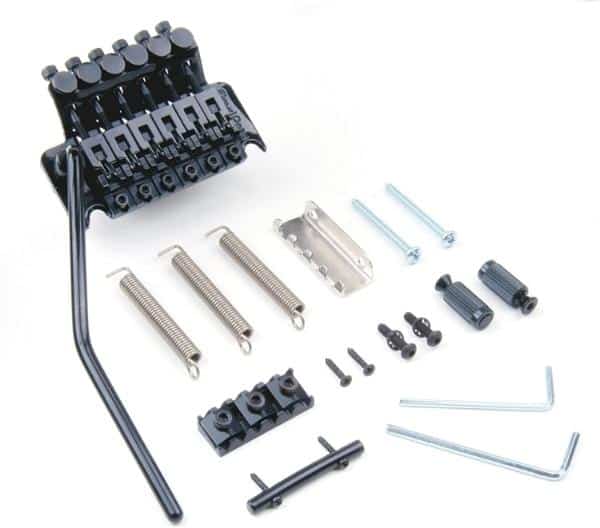
Related Article ➡ Fender Vs Floyd Rose – Which Tremolo Bridge Is Best For You?
Are You Qualified To Make Guitar Adjustments Or Modifications?
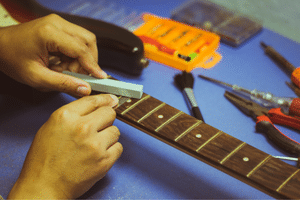
It’s great to work on your guitars, especially if you have a lot of them, but you should always be aware of your limitations.
Adjusting things like an electric guitar’s string height (action) or pickup height can be straightforward. Still, some adjustments require the proper training and experience, like adjusting a guitar’s truss rod and switching out the tremolo bridge.
When you doubt your ability to adjust, repair, or modify your guitar, it’s always best to bring it to a competent guitar technician or luthier (guitar designer & builder). You can permanently damage your guitar, and it might never play and sound right again!
Making modifications to your guitar can void its manufacturer’s warranty and cause permanent damage to the instrument. Certain modifications are irreversible, so you may be stuck with them, even if you desperately want to restore the guitar to its original condition!
I learned that the hard way over the years until I did a three-year apprenticeship in a guitar repair shop. Now I have my own home workshop with the proper training and equipment to safely maintain and repair all my instruments.
Remember: “When In Doubt, Send It Out!”
Frequently Asked Questions

Here are some of the questions I get asked about tremolo bridges.
If your question does not appear here, please put it in the comments, and I will get right back to you with an answer.
Which Tremolo Bridge Is Best?
There is no one “best” tremolo bridge. You should try a variety of guitars and choose one that works best for your playing style. Ultimately, you may end up with more than one guitar, perhaps a second instrument with a 2-point, 6-point, or a Floyd Rose-equipped Strat.
Can You Replace A Tremolo With A Fixed Bridge?
Yes, you can make that replacement, but it won’t sound exactly like a fixed (hardtail) bridge unless you fill in the tremolo cavity with wood.
A better idea would be to block the tremolo, as discussed above. Click HERE to learn more.
Why Is It Called A Tremolo?
That’s a good question! I really don’t know because it should be called a vibrato bridge.
Tremolo is the process of varying the volume of a note, whereas vibrato changes the pitch of a note. Some players do use the term “vibrato bar,” which is technically correct.
How Do You Lock A Strat Tremolo?
You can’t lock a standard 2-point or 6-point Strat tremolo bridge. However, there are some specialty bridges available with a locking mechanism.
Does Bridge Material Affect Tone?
The bridge and saddle material can definitely affect the tone of a guitar. Common bridge and saddle materials include nickel, steel, brass, stainless steel, and titanium.
How Many Springs Should A Tremolo Have?
Most players with a floating tremolo bridge tend to use three springs to make the whammy bar respond more easily to subtle pitch changes.
Players that deck their tremolo bridge are more likely to use four or five springs to prevent the bridge from moving when they bend a string with their fingers. This keeps the other strings from going flat, and they don’t have to bend a string as far to get it up to pitch.
Final Thoughts

I hope this article answered all your 2 vs 6 point tremolo bridge questions, but if it didn’t, leave me a comment, and I’ll get you squared away!
Guitar “purists” typically prefer a 6-point tremolo bridge, while more modern players may be more comfortable with a 2-point bridge.
Your playing style will determine if a floating or decked tremolo bridge will work best for you.
Each bridge type has something to offer in terms of setup, ease of adjustment, tuning stability, resonance and sustain, spring configuration, functionality, and appearance.
I recommend that you play various tremolo bridge guitars and use these comparison criteria plus the checklist included in this article to find the tremolo bridge that sounds and works with your playing style.
It’s important to remember that a tremolo bridge needs to be properly set up for it to function correctly, especially if you change the string gauge, so negotiate a free setup in the price of the guitar.
See How To Keep An Electric Guitar In Tune for more info.

Here’s a video from Premier Guitar that shows you how to set up a 2-point tremolo bridge so that it floats. Check it out!
The procedure for a 6-point tremolo bridge is similar.
Tell Me What You Think

Please leave a comment below if you enjoyed this article, have any questions about tremolo bridges, or want to give your point of view. I will be happy to help you.
- Do you prefer a 2-point or 6-point tremolo bridge? Why?
- Have you tried a floating and a decked tremolo bridge? Which works best for you?
- Did this article help you choose a tremolo bridge?
- What else is on your mind?

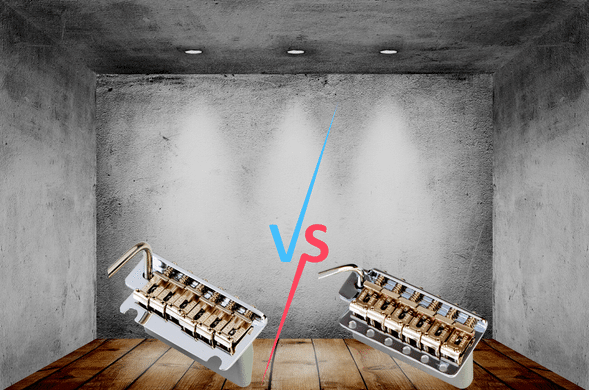

Thank you for this post over 2 vs 6 point tremolo bridge. As someone who is kind of new to playing the guitar, I think that I would do better with a 2 point, because it seems easier to handle. I am also not a very coordinated person, and get frustrated very easily, so if I got too frustrated I would end up breaking my guitar. Do you think that if someone can do good on the six point, they would be naturally good with the 2 point though?
Hi, Jessie
Yes, the 2-point Strat tremolo bridges are typically easier to operate, but a correctly set up 6-point bridge has a more vintage sound.
I don’t see a problem with changing from a 6-point to a 2-point tremolo bridge or vice-versa. It typically only takes a short while to adjust.
Keep on playing!
Frank
The flexibility of the two and 6-point Tremolo bridge makes me give high credit to Fender’s work. Even in the spring materials, he maintained quality and flexibility to the point that the 2 and 6 Tremolo bridges can interchangeably use their springs. Of course, on top of it is the ability to use springs from other manufacturers.
Hi, Ayodeji
Thank You for your comments!
Yes, the Fender Strat tremolo bridges are very versatile, but they need to be set up correctly for the string gauge and your playing style.
I recommend you try the springs that come with the bridge, and then you can change the spring number or material as necessary.
Have & keep on playing!
Frank 🎸
Hi Frank, this is a really useful article and video – thank you.
I’ve had a 6-point, Squier JV series (’83ish) Strat for around 40 years and I think that over that time the springs have probably been swapped in and out, so I’m fairly certain I don’t have the original springs and they’ve become rusty/tarnished and kind of ‘creak’ when flexed – one’s also a different length to the others.
So, I’d like to replace the springs and try 3 springs in floating bridge configuration. Do you have any advice around replacement springs – I’m somewhat bewildered over the choice: Raw Vintage, Fender American Vintage, etc etc. Mine all seem to be 38 ‘winds’. Is there type/make you’d recommend?
Thanks in advance,
Keith
Hi, Keith
Thank You for your comments and question!
The type of springs you use are not typically critical to the sound and performance of your guitar. Technically speaking, the Fender silver springs are made for the 6-point vibratos, and the black springs go in the 2-point vibrato bridges. They do have a bit of a tension difference. I find that the silver ones tend to have a higher tension, especially the springs in vintage Strats.
I’ve mixed various spring types on guitars I’ve built because that’s what I had in stock, without any problems.
What matters more is how many springs you use and the way you set up the vibrato bridge to float. I use three springs on 6-point floating vibrato bridges and two or three springs on floating 2-point bridges, depending on the string gauge and the degree I want the bride to float.
On decked bridges, I usually use 3 to 4 springs and five springs for blocked vibrato units.
I recommend you give three Fender silver springs (American Vintage or whatever you like) a try.
Let me know how you make out. ?
Rock On! ?
Frank ?
Hi Frank..good read.. I have 3 Fender American Specials..they have the 6 point bridge..it was my only affordable choice because the Clapton model has that awful V neck..regards
Hi, Nick
I appreciate the comments!
The American Special Strats are awesome!
The v-shaped neck takes a little while to get used to. I have two Clapton Strats, the first version with the Lace Sensor pickups and the newer version with the noiseless vintage pickups. My newer one has less of a v-shaped neck.
Rock On! ??
Frank ?
Hi Frank,
Thanks for the article. Do you have any thoughts on screw-in tremolo arms vs. pop-in and tips for adjusting each?
Thanks.
Hi David
I typically prefer the pop-in tremolo arms because they are easier to move up and down accurately in small increments. I wrap my screw-in tremolo arms with Teflon plumber’s tape to make them easier to use.
Rock On!
Frank